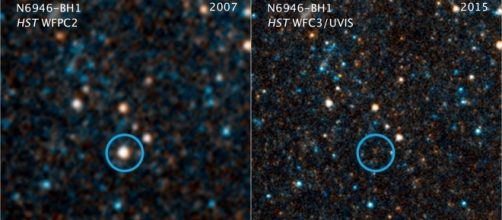NASA have released data showing what is possibly the moment of creation of a black hole. Astronomers said that they have observed a star disappear right before their eyes without giving out a bang. Astronomers have many hypotheses to explain such phenomena but it may be time for them to conclude that these stars are not just vanishing, they're turning into black holes.
What led NASA astronomers to believe that they witnessed the birth of a black hole?
For years NASA has been observing stars and supernovas. However, they were fascinated by the phenomena where a dying star, after becoming luminous for a brief period suddenly vanishes without a trace.
This was the situation with the star called N6946-BH1, which started to brighten in 2009, but suddenly disappeared in 2015 without a trace. Astronomers are often baffled by these occurrences, labeling them as "massive fails" of supernovas. However, as the occurrence of these fails rise, scientists began to wonder if there are other reasons for a star to just vanish.
Recently they've looked again to this star through the Hubble and Spitzer telescopes and saw that the star had indeed vanished completely. After a strict process of elimination of pertinent explanations, they have concluded that what had happened was the exact moment when a black hole is born.
Christopher Kochanek an Astronomy professor at the Ohio State University said that black holes may be the explanation for the sudden disappearances of supernovas after a few moments of brilliance and this conclusion spearheaded this new understanding on the life and death of stars.
How will this affect astronomers' understanding about stars and black holes?
According to Krzystof Stanek, co-author of the study of this phenomena, this discovery will explain how super massive black holes are created. Before, it was believed that black holes occur after a star becomes a supernova, but now it is slowly coming to be accepted that black holes may occur without giving off a spectacular light show.
Stanek added that it might be easier for a massive star to become a black hole than turning into a supernova. NASA admits that it is much too early to conclude how often supernova fails happen in the Universe, but through this project, one can estimate its apparent frequency.
It may be that black holes are not novelty occurrences in the universe, but a norm that astronomers just happen to overlook. The flare of supernovas may have hidden the true fact that black holes happen often, and according to recent data, much more often than astronomers previously thought.


